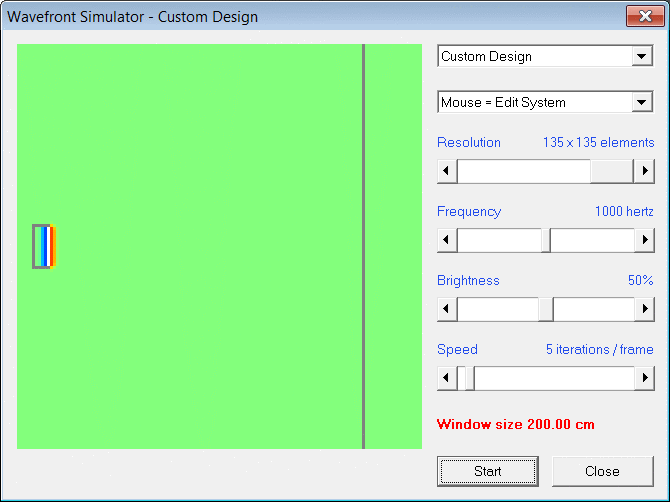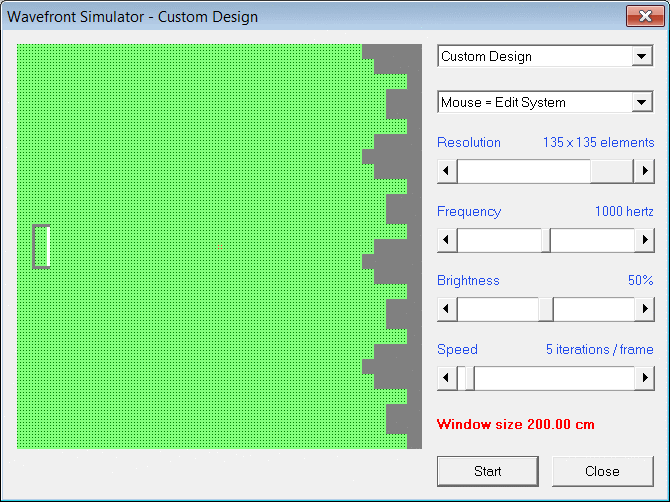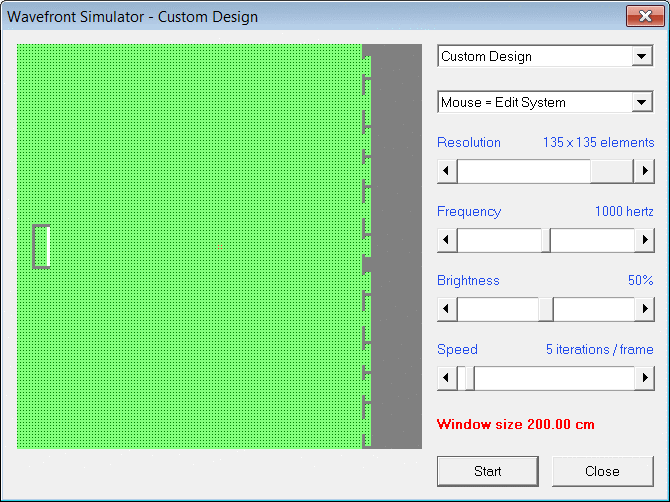Pascal Pharmacon posted an interesting article yesterday, so I thought I'd find out how they perform:
https://phys.org/news/2017-06-diffuser-ten-thinner.html
From what I can tell, this is a conventional quadratic diffuser, but the "wells" in the diffuser have been squashed so that the sound radiates radially.
So let's find out!

First off, here's a sim of how sound radiates in a room. The dimensions of the sim are 200cm x 200cm (6.5' x 6.5')
The speaker on the left is 20cm in diameter (8")
The frequency is 1000Hz
https://phys.org/news/2017-06-diffuser-ten-thinner.html
From what I can tell, this is a conventional quadratic diffuser, but the "wells" in the diffuser have been squashed so that the sound radiates radially.
So let's find out!

First off, here's a sim of how sound radiates in a room. The dimensions of the sim are 200cm x 200cm (6.5' x 6.5')
The speaker on the left is 20cm in diameter (8")
The frequency is 1000Hz

Here's the same sim as above, but this time with a conventional quadratic diffuser. The dimensions of the sim are 200cm x 200cm (6.5' x 6.5')
The speaker on the left is 20cm in diameter (8")
The frequency is 1000hz.
Here's some things I notice:
With a flat wall, you get a reflection that's almost like a mirror, it bounces right back at the loudspeaker. This might be a good reason to set your room up diagonally.
With the diffuser, you still get a reflection, but it's not as strong.
I used this calculator to generate the dimensions of the diffuser:
QRD Diffuser Well Depth Calculator
Here's the properties of the diffuser:
Well Number Residue Well Depth (Inches)
0 0 0.00
1 1 2.25 (2 1/4)
2 4 9.00
3 2 4.50 (4 1/2)
4 2 4.50 (4 1/2)
5 4 9.00
6 1 2.25 (2 1/4)
Approximate frequency range: 430 - 2260 Hz
Well Width (inches)
3
Max Well Depth (inches)
9
Wells per Period
Calculate
Very interesting. Several years ago I ran into a similar idea. Essentially an acoustic absorbent panel, with a thin reflective cover. The cover was drilled with round holes according to some mathematical principle.

Here's the exact same quadratic diffuser as post #2, but this time I've "squashed" the wells so that they're radial.
Much to my surprise, this seems to work arguably better! Go figure. I thought it would work a little, but not as well as a "real" quadratic diffuser.
I can only speculate why this is. Perhaps the ninety degree bend in the diffuser is destructive, just as bends in a horn are destructive?
If so, this might increase the bandwidth of the diffuser, basically the bends would behave as a low pass filter.
It's a hybrid trap/diffuser. How does it work at other frequencies? Also, one thing to keep in mind, the larger the diffuser, the more you can step the depth (even if it's the same repetitive unit just stepped away from the wall) to further break up modes.
Another, related idea was for Tsunami's. Some research was done in using square pylons, arranged in a simple, repeating grid pattern. Something like this:
[] [] [] [] [] []
[] [] [] [] [] []
[] [] [] [] [] []
So if you can imagine the wave front coming from the top, each transition would cause the sound to re-radiate, so that most of the sound went side-ways instead of straight down. So you'd have an incoming flat waveform, but at each exit from between the pylons the sectional waves would be transformed into multiple cylindrical sources.
Best,
E
[] [] [] [] [] []
[] [] [] [] [] []
[] [] [] [] [] []
So if you can imagine the wave front coming from the top, each transition would cause the sound to re-radiate, so that most of the sound went side-ways instead of straight down. So you'd have an incoming flat waveform, but at each exit from between the pylons the sectional waves would be transformed into multiple cylindrical sources.
Best,
E
Are the same principles at play here, in the tsunami proposal, and "enabl" patterns from BudP? A "simple" disruption of energy transfer either through or off of (diffuser panels) a particular boundary?
croat, I have no idea, I'm afraid this is all beyond me, but stuff I kind of read about from time to time. 🙂 Hopefully Patrick will opine soon.
Erik
Erik
With a flat wall, you get a reflection that's almost like a mirror, it bounces right back at the loudspeaker. This might be a good reason to set your room up diagonally.
This has been on my mind lately as I'm looking to buy a house and a good music room with a tall ceiling is a requirement. But the layout on some I've looked at would require a diagonal axis of the speakers and listening position if I wanted keep side reflections far away, and have nothing behind my head, two things that IME really muck up the sound.
BTW here is a link to the full paper:https://journals.aps.org/prx/abstract/10.1103/PhysRevX.7.021034 Would love to see someone take this idea and develop a DIY usage!
croat, I have no idea, I'm afraid this is all beyond me, but stuff I kind of read about from time to time. 🙂 Hopefully Patrick will opine soon.
Erik
When I searched for "tsunami diffuser" all the hits were for some bong company
Essentially an acoustic absorbent panel, with a thin reflective cover.
It's not an uncommon practice, often achieved with a sheet of plastic between the absorbant panel core and the exterior fabric. We're considering it for a studio that doesn't have room for panels thick enough to absorb in the low vocal ranges. Thin panels have a tendency to make a room sound muffled/overly warm.
Hi Patrick (John),
Try the free trial of this: Software - AFMG Reflex
It's what the pros use, in my opinion the best out there and relatively simple
Cheers,
Kees
Try the free trial of this: Software - AFMG Reflex
It's what the pros use, in my opinion the best out there and relatively simple
Cheers,
Kees
Hi RDF, what I was thinking about was the RPG panels, which are until now unique to me. 🙂
Best,
E
Best,
E
HelloPascal Pharmacon posted an interesting article yesterday, so I thought I'd find out how they perform:
New sound diffuser is ten times thinner than existing designs
From what I can tell, this is a conventional quadratic diffuser, but the "wells" in the diffuser have been squashed so that the sound radiates radially.
So let's find out!

First off, here's a sim of how sound radiates in a room. The dimensions of the sim are 200cm x 200cm (6.5' x 6.5')
The speaker on the left is 20cm in diameter (8")
The frequency is 1000Hz
I know this is an old post, but i have been trying to model / simulate for a few custom diffuser designs.
can you please let me know what software this is ?
also is it possible to have this simulation in 3D ?
any help would be greatly appreciated.
thanking you in advance
Regards.
Fenil
Hey.. thank you very much for responding.. would it work in 3 dimensions ?
How Can I share a few pics of my designs .. if you can guide me please ?
How Can I share a few pics of my designs .. if you can guide me please ?
- Home
- General Interest
- Room Acoustics & Mods
- Simulating a sound diffuser